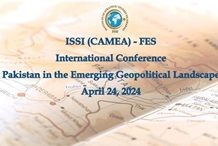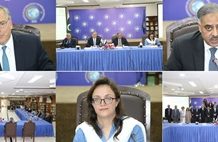The sudden rise of the social movement rejects the conventional analysis that the youth is depoliticised and mainly interested in advancing their careers
What we are witnessing in Pakistan these days is a new social movement that is remarkably different from the ones launched against dictators in the past. It is not being driven as much by the old-fashioned, deal-making power elites as it is by strong popular sentiment among the Pakistani youth inside and outside the country. What is this popular sentiment, and why are the Pakistani youth at the centre of it? What explains the rise of this new social movement? What are its aims, and its chances of success?
It is heartening that while the power-elites were still debating how the imposition of martial law in the country would hurt them or create fresh opportunities of cooptation, college and university students along with young media and legal professionals instantly realised the enormity of the act of trashing the constitution and throwing the vast majority of judges of the superior judiciary out of the system.
It is perhaps for the first time in the political history of the country that legal and constitutional issues, hitherto a domain of the expert, have entered into the popular imagination with a powerful reminder that what happens in the superior judiciary is a matter of public concern. The unfolding of political events since March and the manner in which the media presented and debated the question of independence of the judiciary on the one hand, and the efforts of the executive to subvert it, brought into sharp relief the value of rule of law, dissent and the larger question of representation in the structures of power.
The judicial crisis and the lawyers’ movement captured the attention of all sections of society. But more than any other, the youth became interested in the identity of their state who controls and runs it and for what purposes and learnt their first lesson in politics. The lesson was that one or few individuals associated with powerful formal institutions and informal social structures have absolute control over the state and do not care about public interests.
In the past, ruling elites got away with acts of corruption, martial laws and emergencies because they could easily manage and control society through a co-opted intermediating class comprising landowners, caste and tribal chiefs and other socially influential figures with an inherent stake in the elitist power structure, often directed and manipulated by the men in uniform. Their recent moves against the constitution and the judiciary are based on the old assumptions about society. Their reading of the changes that have occurred on a global, regional and domestic level does not seem realistic.
Demographically, the youth constitutes the largest part of Pakistan’s population. Some of them are enrolled in various modern educational institutions, while others in madrassas. A major portion of the youth, however, remains uneducated and unemployed. Despite belonging to different social strata, they share disrespect for Pakistani power structures and systems of governance. They also have a common vision of a state that is representative and responsive to the needs of society, something elite-dominated or military-ruled states are not.
Not all sections of the Pakistani youth possess the same social capacities, political vision or leadership qualities because of their different social backgrounds and degree of exposure to the modern world. College and university graduates have assumed the vanguard role in the emerging social movement of Pakistan. This is a very different generation from the one that had participated in the anti-Ayub agitation. It is distinctive in intellectual development and skills, and is technology savvy. It is wired with the international civil society and likeminded groups everywhere, and can access real time information about events.
The most important thing about the rise of the new social movement is that the young Pakistanis have acquired political socialisation in a globalised context with deeper knowledge and understanding of positive changes taking place in other countries, and how their own country is being governed. This generation opened its eyes in the martial law of Zia-ul Haq and has matured in the double martial law of Pervez Musharraf. They are justified in being dismayed and discontented over how their nation and statehood have been repeatedly violated by rapacious military and civil elites.
The sudden rise of the social movement rejects the conventional analysis that the youth is depoliticised and mainly interested in advancing their careers. A movement starting in an elite institution like LUMS tells a very different story about this student body, both in private and public universities, that has been organising protest meetings, rallies and demonstrations since the proclamation of emergency rule. They are more interested in the future of their country: how it is ruled, by whom and for what purposes.
They have a very different sense of patriotism as they want the country to be civilised, respected internationally and governed under universal norms of law and justice. Let there be no mistake about the new social movement: it is not about resuming political musical chairs with the usual actor or actors turning on and off the tune. This movement, though in its early stages, is essentially about structural change: it demands the restoration of the constitution and the judiciary, the twin victims of the current martial law. It is also about freedoms, rule of law and basic human decency values at the heart of modern civilisation that the ruling cliques have violated at will.
We can’t leave this discussion without asking the question: will it succeed? Given political developments over the past forty years, the old system of power is so unnatural, humiliating, and even unpatriotic that it cannot survive for too long. There is national revolt against it, to which the youth, more than any other sector, is contributing to with an unusual motivation and commitment.
This is not likely to end even if the presently dysfunctional regime of General Musharraf takes immediate remedial actions, like holding elections or lifting the state of emergency. The focus of the struggle is the constitution and an independent judiciary, including reinstatement of judges axed by the martial law, and redefinition of the role of the military in Pakistani politics. This is bound to happen, but the when and how is yet to be seen.
Signs of the demise of perhaps the last martial law are everywhere. Defiance is growing, and is taking new and innovative forms. And, there is close networking among civil society groups and resistance is being aided by technology.
The primitive, elite-led state faces a serious challenge from a very modern civil society. It would not be difficult to foretell the winner.
The author is a professor of Political Science at the Lahore University of Management Sciences.












